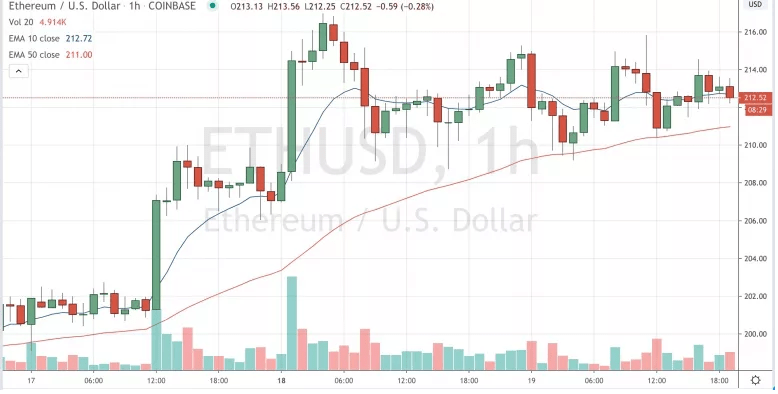Here’s Why Ether’s Price Has Jumped 65% So Far This Year
May 20, 2020 @ 15:08 +03:00
While bitcoin (BTC) is often discussed as the cryptocurrency best suited for turbulent times, the price of ether (ETH), the second-largest digital asset by market capitalization, has been substantially outperforming bitcoin since the start of 2020. But ether has much different technical dynamics to consider than bitcoin.
As of 20:00 UTC (4 p.m. ET), ether was trading at $211, a loss of less than a percent over the past 24 hours. The native cryptocurrency of the Ethereum network was close to its 10-day moving averages, a technical indicator signaling sideways trading, with little price movement. Ether dropped as low as $209 earlier in the day on exchanges such as Coinbase, then hit $215 at 11:00 UTC (7 a.m. ET).
Amid the recent hype about the halving, a once-in-four-years event that reduced the supply of bitcoin and the proclamations of investors like Paul Tudor Jones II that bitcoin is a good investment in an extraordinary economic era, ether’s price has outperformed it. For the year to date, ether is up a whopping 65% while bitcoin has risen 35% for the same period.
A much smaller market capitalization for ether likely helps ignite larger price movements versus bitcoin, says Vishal Shah, a cryptocurrency options trader. “ETH’s materially smaller market-cap, on a nominal basis, thus benefits on the margin.” Ether currently has a $23 billion market capitalization versus bitcoin’s $144 billion, according to data from CoinGecko.
“Ether has long been tracking bitcoin’s price action, albeit with higher beta. This means that when bitcoin surges in value, ether’s value usually increases as well by an even greater percentage,” said Michael Anderson, co-founder of Framework Ventures.
Anderson’s firm Framework is focused on decentralized finance, or DeFi, investments. DeFi uses the Ethereum network for various cryptocurrency services such as stablecoins, lending and derivatives.
The prospect of decentralized financial applications helps fuel interest in ether as an investment, says Danny Kim, head of revenue for cryptocurrency liquidity provider SFOX. “To the extent that ether is outperforming bitcoin and becoming a more active network, a big factor to consider is the DeFi sector,” he told CoinDesk.
Ether holders can “lock” the cryptocurrency into a DeFi smart contract address to gain yields on various lending and stablecoin applications on the network. Locking ether into DeFi effectively reduces the supply of ether in circulation for trading, a dynamic that reduces liquidity. “DeFi has become incredibly popular, and large portions of ETH are getting locked up as collateral, removing them from the liquid market,” said Framework’s Anderson.
Indeed, at one time, ether users had locked up over 3.2 million ETH in network smart contracts this year, although that number is down from February highs, according to data analytics firm DeFi Pulse. There are nearly 111 million ETH outstanding.
Nonetheless, traders still prefer bitcoin’s liquidity, regardless of ether’s year-to-date performance. While ether has $42 million in daily volume on spot exchange Coinbase, bitcoin’s volume is almost three times higher, averaging $125 million on the San Francisco-based trading platform. Thus, traders have to carefully balance ether’s profit potential with the fact that its order books are thinner than bitcoin, which can lead to slippage and potential losses when price makes huge swings. In addition, the Ethereum network is planning to go through an ambitious technical transition, Eth 2.0, creating a degree of uncertainty.
Market Wrap: Here’s Why Ether’s Price Has Jumped 65% So Far This Year, CoinDesk, May 20








